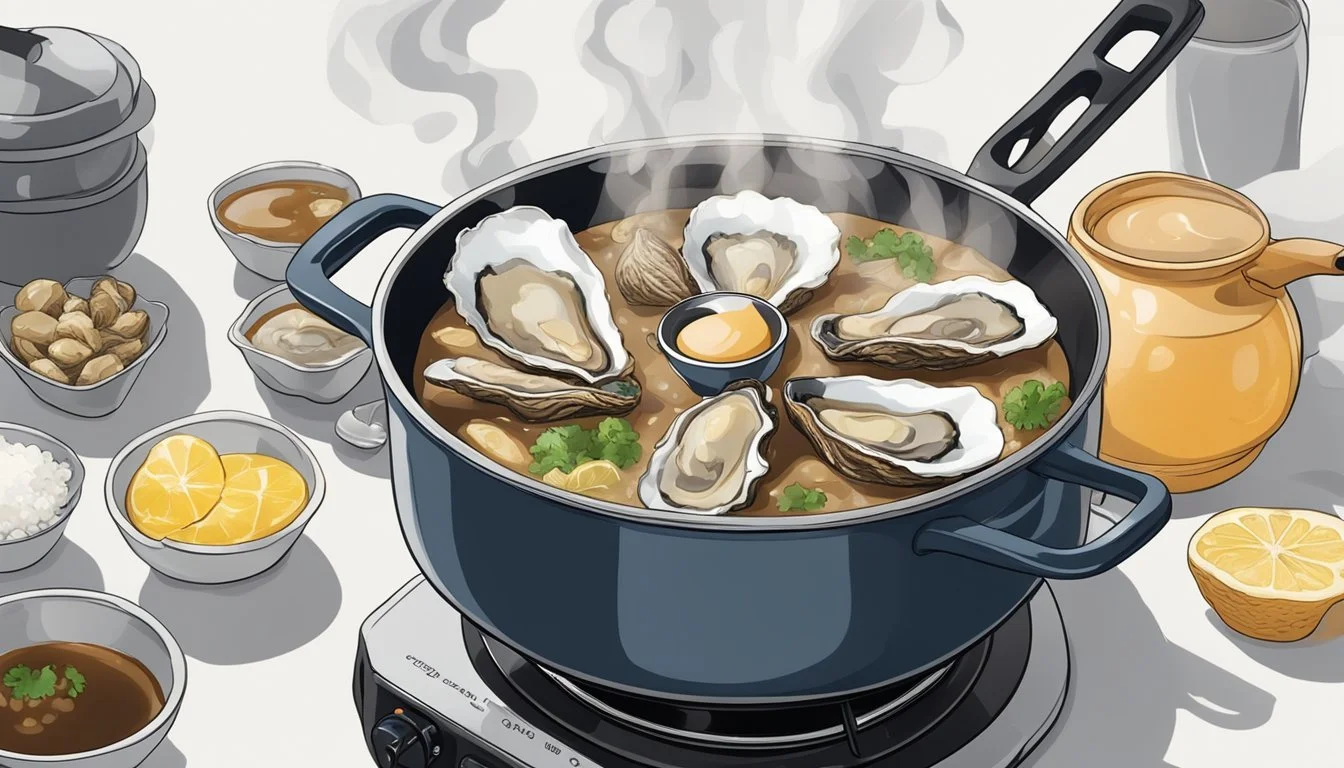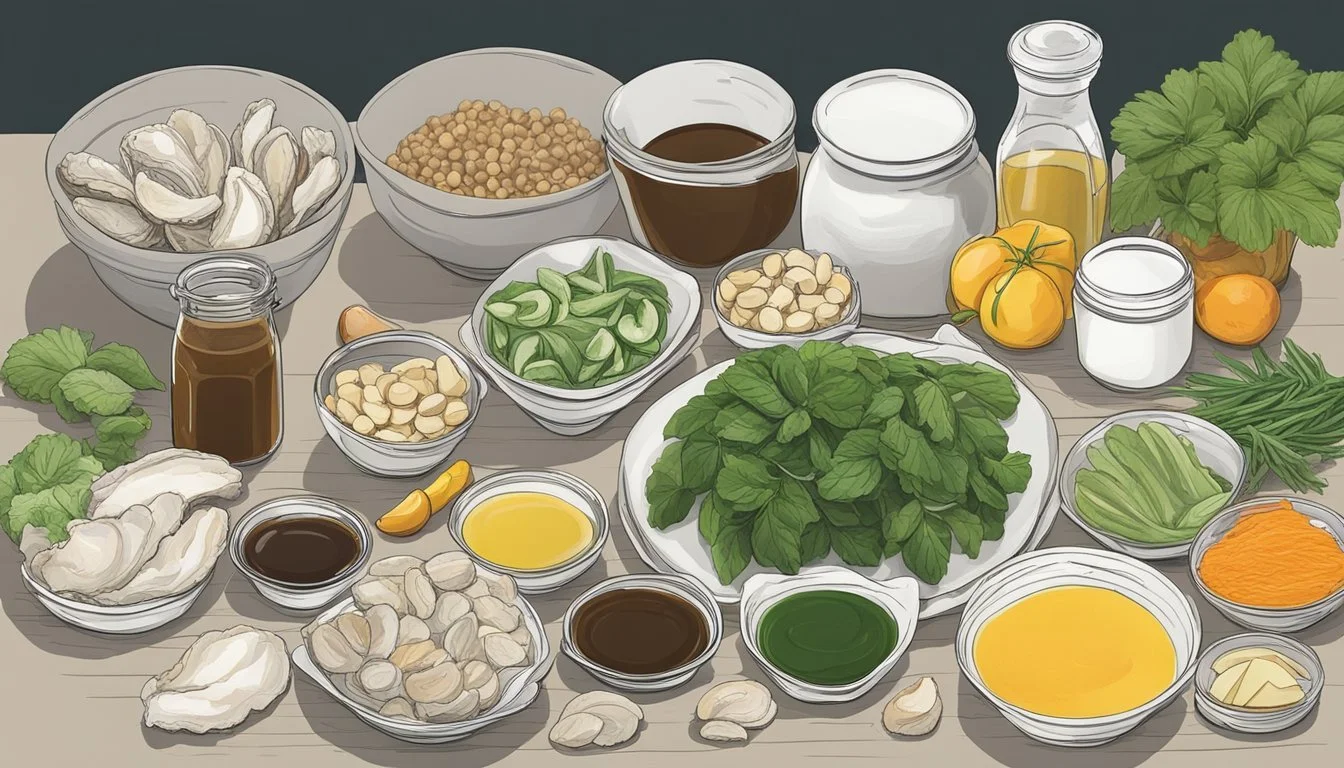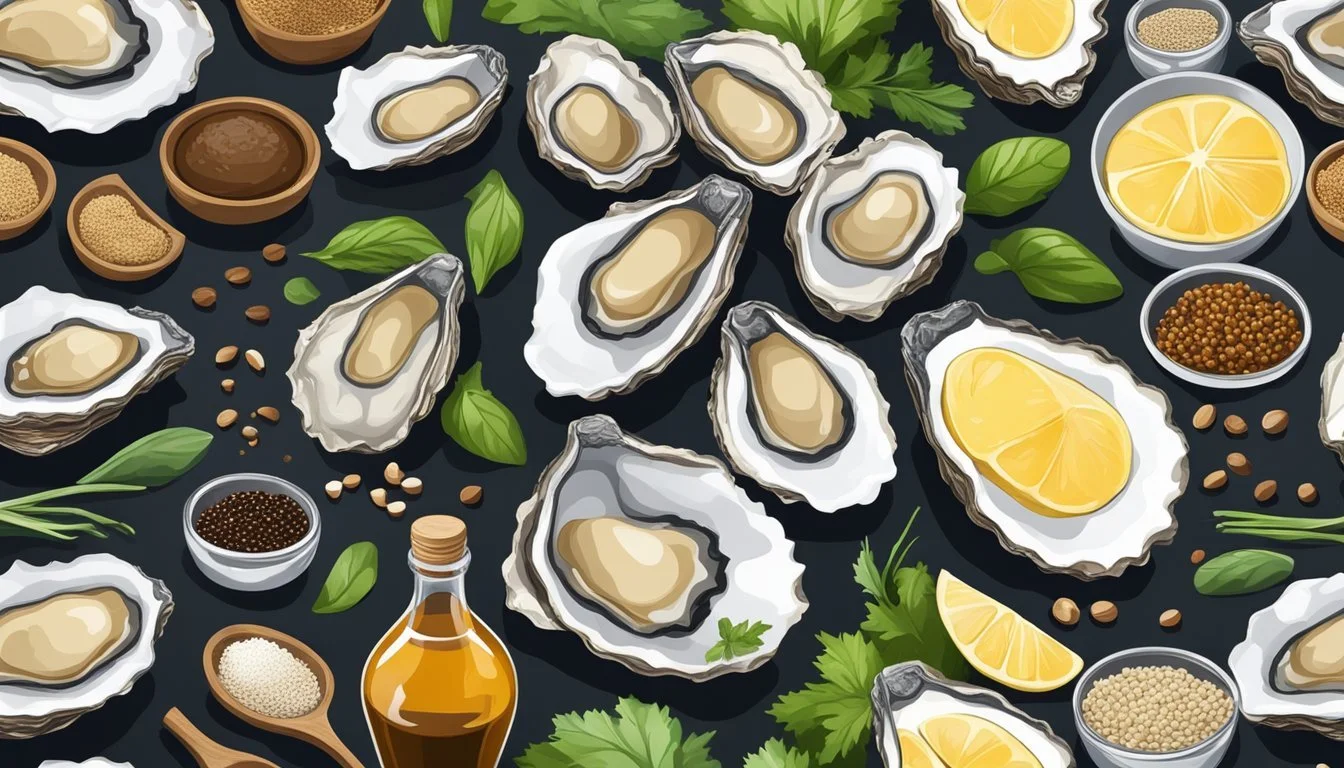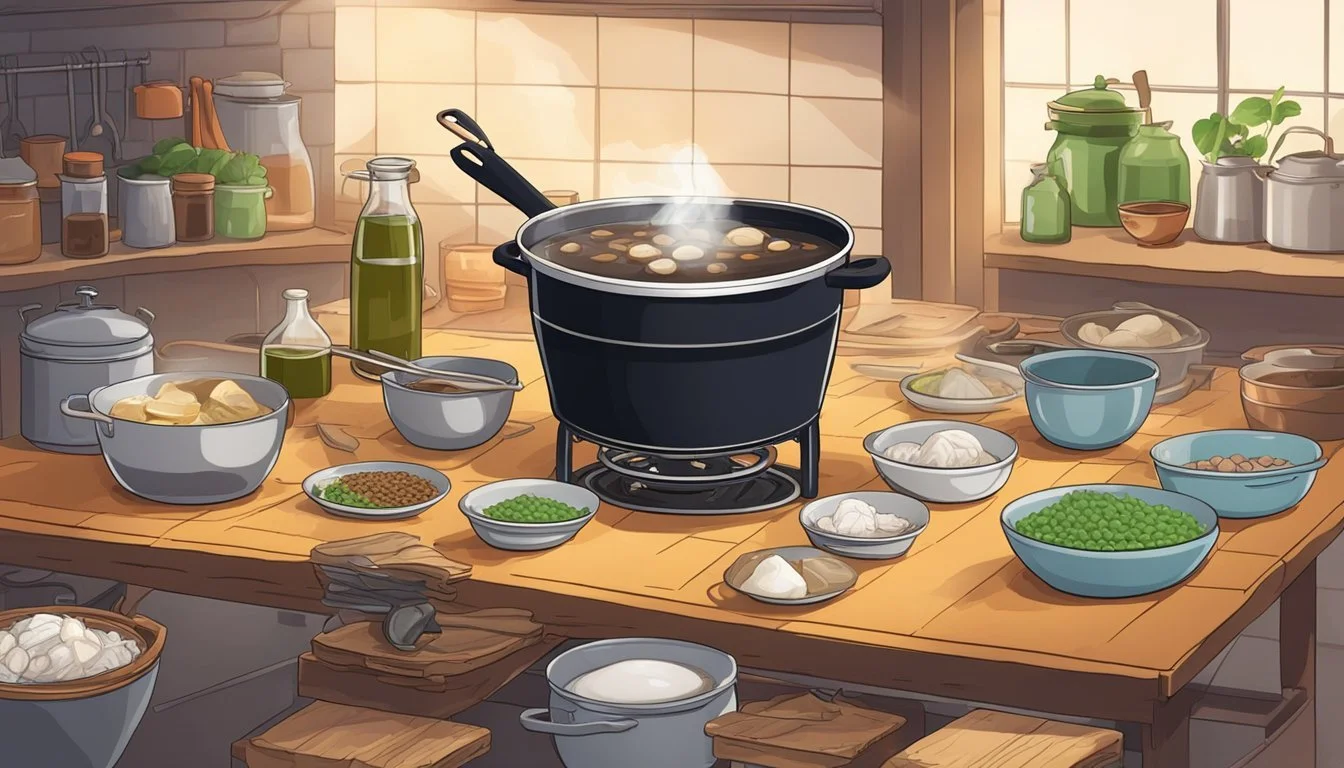How to Make Flavorful Oyster Sauce from Scratch
A Step-by-Step Guide
Homemade oyster sauce is a cherished condiment in many cuisines, offering a distinctive umami flavor that enhances a wide range of dishes. Its savory depth is highly sought after, especially by those who appreciate the complexity it brings to the palate. Crafting oyster sauce from scratch allows for a personal touch, enabling the cook to balance flavors according to their own preference, and ensures that the final product is free of artificial additives.
The process of making oyster sauce involves gently simmering oysters (What wine goes well with oysters?) to extract their rich, briny essence. This liquid gold is then seasoned and reduced to create a sauce that is both robust and versatile. Often incorporated into stir-fries, marinades, and as a topping for vegetables and proteins, oyster sauce is a critical ingredient in many Asian cuisines and has been adopted globally by chefs seeking to add a layer of flavor complexity to their creations.
By choosing to make oyster sauce at home, one not only embarks on a culinary adventure but also gains control over the ingredients, which can lead to a healthier and more flavorful condiment. The satisfaction derived from this hands-on approach to cooking is matched only by the enhanced taste it brings to the table.
Understanding Oyster Sauce
Oyster sauce is a key ingredient in Asian cuisines, especially within Chinese cooking, known for its ability to impart a rich umami and savory flavor profile to a variety of dishes.
History of Oyster Sauce
Oyster sauce originated in Guangdong province, China, by a man named Lee Kum Sheung in the late 19th century. He accidentally developed the sauce while attempting to make a traditional oyster soup. The oysters were left to cook for an extended period, resulting in a thick, brown sauce that was distinct in its robust, savory taste. Lee Kum Sheung went on to establish the Lee Kum Kee company, which has become synonymous with the production of oyster sauce and a variety of other Asian condiments.
Culinary Significance
In the realm of Asian cuisine, notably Chinese cooking, oyster sauce is treasured for its savory flavor and versatility. Umami—the fifth basic taste characterized as savory and meaty—is abundant in oyster sauce, which enhances the overall flavor experience of a dish without overpowering it. The condiment is essential in creating the authentic taste of classic dishes such as stir-fries and marinades. Oyster sauce is integral to both traditional and contemporary Asian cuisines, solidifying its position as a staple condiment in many kitchens around the globe.
Ingredients and Substitutes
Creating a flavorful oyster sauce from scratch requires an array of ingredients, each playing a crucial role in developing the sauce's depth and umami. From choosing fresh or pre-shucked oysters to selecting the right kind of soy sauce and sweeteners, the integrity of these ingredients can make or break the final product. Additionally, the section provides insights into vegan and gluten-free substitutes to accommodate dietary restrictions.
Choosing Fresh Oysters
One seeks fresh or pre-shucked oysters to obtain the vital oyster extract. Freshness is paramount, as it directly affects the sauce's umami quality. For those unable to source fresh, live oysters, pre-shucked oysters in their liquid can be a convenient, yet equally flavorful, alternative.
Fresh Oysters: Ensure they are plump, with a fresh sea aroma and closed shells.
Pre-shucked Oysters: Look for options stored in natural juice with minimal additives.
Sourcing Quality Soy Sauce
A robust base for the seasoning layer, soy sauce is non-negotiable in crafting authentic oyster sauce. One might opt for a combination of light and dark soy sauces – light for saltiness and dark for color and a richer taste.
Light Soy Sauce: Adds a salty dimension without overpowering the delicacy of the oyster flavor.
Dark Soy Sauce: Provides a deeper color and a slightly sweet, more complex flavor profile.
Natural Sweeteners and Salt
Sweeteners balance the sauce's salinity while salt accentuates its savory elements; both are essential. Sugar or a substitute like brown sugar adds a mild sweetness that complements the salt and soy sauce, creating a harmonious flavor.
Sugar: A staple to counterbalance saltiness, resulting in a nuanced sauce.
Salt: Used to taste, it should enhance, not dominate, the profile of the sauce.
Vegan and Gluten-Free Alternatives
Vegetarian mushroom sauce emerges as an excellent vegan substitute for oyster sauce, boasting a similar umami character. For those on a gluten-free diet, gluten-free tamari can replace regular soy sauce. Moreover, flax seeds soaked and ground into a paste offer a thickening solution in lieu of wheat-based thickeners.
Vegetarian Mushroom Sauce: An umami-rich, vegan-friendly option serving as a direct substitute.
Gluten-Free Tamari: A wheat-free soy sauce alternative, ideal for gluten-free requirements.
Flax Seeds: Ground into a paste, can thicken the sauce without gluten-based additives.
Preparation Techniques
The creation of oyster sauce largely depends on proper preparation techniques involving shucking, simmering, and thickening to impart deep flavor and the characteristic silky consistency.
Shucking and Cleaning
To start, shucking oysters requires care to preserve their integrity for the sauce. It's recommended to use a clean spoon to gently detach the oyster meat from the shell. Once shucked, it's important to clean the oysters thoroughly. Rinse them under cold water, being cautious not to break the delicate meat. This step ensures a clean, fresh flavor base for the sauce.
Simmering for Flavor
Adding the cleaned oysters to a pot, they should be covered with water and brought to a simmer. During this simmering process, flavors release from the oysters, creating a rich broth. For an extra flavor enhancer, ingredients like soy sauce, sugar, and spices such as ginger and garlic can be added. Keep the heat low, gently stirring occasionally to allow the flavors to meld together without overcooking the oysters.
Thickening Methods
The thickening of oyster sauce traditionally relies on reduction, but there are quick alternatives. One can use cornstarch as a thickener for a faster result without compromising on texture. To do this, dissolve cornstarch in a small amount of water and add it to the simmering broth. Stir continuously with a clean spoon until the desired consistency is reached, ensuring the sauce thickens evenly without clumping.
Cooking with Oyster Sauce
Oyster sauce is a versatile ingredient that can elevate the taste of various dishes through its savory depth and umami-rich flavor. Here’s how to integrate oyster sauce into everyday cooking to transform simple ingredients into delectable meals.
Incorporating into Marinades
Using oyster sauce in marinades adds a robust flavor that penetrates meat, tofu, or vegetables. For meats like beef or chicken, mix oyster sauce with ingredients like soy sauce, garlic, and a touch of sugar to balance the saltiness. Marinate for at least an hour or overnight for best results.
Marinade Ratio Example for Meat (Beef/Chicken):
Oyster Sauce: 2 tablespoons
Soy Sauce: 1 tablespoon
Minced Garlic: 1 teaspoon
Sugar: 1/2 teaspoon
For tofu or vegetables, a lighter marinade can be made by diluting the oyster sauce with a bit of water or vegetable stock.
Enhancing Stir-Fries and Soups
In stir-fries, oyster sauce works as a perfect seasoning to add depth to the dish without overpowering the natural tastes of the vegetables, meat, or noodles. Add oyster sauce to the pan early on to coat the ingredients evenly. A tablespoon can transform a simple stir-fry into a richly flavored dish.
Basic Stir-Fry Ingredients:
Vegetables: 2 cups (e.g., broccoli, bell peppers)
Meat or Tofu: 1 cup, pre-cooked
Noodles or Rice: 1 cup, pre-cooked
Oyster Sauce: 1 tablespoon
In soups, oyster sauce can be added to the broth to enhance complexity. Just a teaspoon can deepen the profile of Asian soups, marrying well with other traditional ingredients like ginger and green onions.
Creating Dipping Sauces
The thick consistency and potent flavor of oyster sauce make it an ideal base for dipping sauces. To cater to different palates, it can be combined with ingredients like chili oil for heat, vinegar for acidity, or a bit of honey for sweetness.
Dipping Sauce Recipe for Spring Rolls/Dumplings:
Oyster Sauce: 1 part
Sesame Oil: A few drops for fragrance
Rice Vinegar or Lime Juice: to taste, for acidity
Optional: Chili Oil or Minced Ginger for an extra kick
The sauce pairs well with spring rolls, dumplings, and can even be used as a dip for simple crudité.
Storage and Preservation
Proper storage of homemade oyster sauce maximizes its shelf life and maintains its quality. Straining the sauce thoroughly and using clean utensils for serving are pivotal to avoiding contamination.
Refrigerating Homemade Sauce
Homemade oyster sauce should be stored in the refrigerator to preserve its freshness. Ideally, refrigeration can extend the sauce's shelf life to about one week. The sauce should be kept in an airtight glass container or bottle to prevent the absorption of other flavors from the refrigerator. To serve, always use a clean spoon to prevent introducing bacteria into the sauce.
Freezing for Long-Term Use
For longer storage, freezing homemade oyster sauce is an effective method. Freezing can prolong the shelf life for up to six months. When freezing, it's advised to pour the sauce into an ice cube tray, allowing for easy and convenient portioning later on. Once frozen, transfer the cubes into a sealable freezer bag, making sure to expel as much air as possible before sealing to prevent freezer burn.
Avoiding Contamination
To prevent contamination that could lead to spoilage, it is crucial to:
Use sterile containers for storing.
Always handle the sauce with clean utensils.
Strain the sauce through a fine sieve to remove any solid particles, as these can shorten the storage life.
Remember, the key to effective preservation is minimizing exposure to air, heat, and contaminants.
Nutritional Information
When considering the nutritional aspects of homemade oyster sauce, it is useful to examine both its caloric content and the health benefits of its primary ingredient, oyster extract. This analysis provides insight into the potential dietary contributions of the sauce.
Caloric Content
Homemade oyster sauce is relatively low in calories. A standard serving size typically contains:
Calories: 9 kcal per tablespoon (approximate)
Protein: 1 gram
Total Fat: Less than 1 gram
In contrast to commercially prepared versions, homemade oyster sauce can contain fewer additives, potentially resulting in a lower caloric count depending on the recipe used.
Benefits of Oyster Extract
Oyster extract, the fundamental component of oyster sauce, is rich in nutrients:
Iron: A mineral essential for blood health.
Umami Flavor: A savory taste that is naturally satisfying, potentially reducing the need for additional salt.
The oyster extract not only imparts a robust umami flavor but also provides a source of iron. This can be beneficial in a balanced diet, particularly for individuals requiring increased mineral intake.
Comparisons and Cost Analysis
In evaluating homemade versus store-bought oyster sauce options, it's necessary to consider factors such as cost-effectiveness and ingredient control. The analysis below compares these two approaches, with a focus on the implications of adding various seasonings and preservatives.
Homemade vs Store-Bought
Homemade oyster sauce presents an opportunity to control the selection of ingredients, resulting in a product free from preservatives and additives like MSG, which are commonly found in store-bought versions. The initial setup for a homemade batch might seem costly due to the upfront purchase of ingredients, but it's important to note that these ingredients can yield multiple batches.
Cost Breakdown (Homemade):
Oysters: Prices vary, but assume a starting cost of $5 for 20oz.
Seasonings (soy sauce, sugar, salt): Approximately $2 for sufficient quantities.
Additional Flavor Agents (optional): Ginger, garlic, onions, etc., around $1.
Cost Comparison (Average Store-Bought Bottle):
9 to 12 oz bottle ranges from $3 to $5, often containing additives for preservation.
The cost per ounce can be lower when preparing oyster sauce homemade, especially when considering bulk creation. Moreover, the absence of preservatives potentially makes homemade oyster sauce a healthier option.
Assessing the Value of Additives
Additives in store-bought oyster sauce, such as MSG, serve to enhance flavor and extend shelf-life. When preparing homemade oyster sauce, the cook can determine the level of seasonings and opt for natural alternatives like sea salt or organic sugar to replace conventional additives. This allows for a product that aligns with preferences for natural ingredients over synthetic preservatives.
Value Assessment of Additives:
MSG and Preservatives: Increase shelf-life and umami flavor but with potential health concerns.
Natural Seasonings (Homemade): Offer pure flavors but may result in a shorter shelf-life.
One must weigh the longer shelf-life of store-bought sauces with their content of additives against the fresh, preservative-free qualities of a homemade batch. In terms of cost, if long-term health implications and flavor preferences are priorities, homemade sauce may offer superior value despite the investment in time and initial ingredient purchase.
Serving Suggestions
Once a batch of homemade oyster sauce is prepared, its robust flavor and rich aroma can transform a variety of dishes. Knowing how to pair and incorporate oyster sauce into meals can elevate the dining experience.
Ideal Pairings
Oyster sauce pairs exceptionally well with numerous base ingredients, enhancing their natural flavors.
Rice: A drizzle of oyster sauce can add depth to plain white or fried rice.
Noodles: Both stir-fried and steamed noodles benefit from the savory notes of the sauce.
Chicken: It serves as a rich marinade or glaze that intensifies the taste of chicken dishes.
Beef: The umami quality of oyster sauce complements the richness of beef, whether in a stir-fry or as part of a marinade.
Creative Culinary Creations
The versatility of oyster sauce invites innovation in various culinary creations.
Soups: Introduce a tablespoon into broths for an umami-packed flavor.
Marinades: Combine with garlic, ginger, and other seasonings to marinate meats.
Stir-fries: Enhance vegetable or protein stir-fries with its caramel-like sweetness and saltiness.
Culinary Innovations: Cooks can explore its use in unconventional dishes such as in sauces for pizzas or even in fusion tacos.
Experimenting with oyster sauce can lead to unique flavor profiles and takes traditional recipes to new heights.
Cultural Impact and Global Cuisine
Oyster sauce, a pivotal ingredient in Asian cuisine, has significantly influenced the culinary practices around the world. Originating in southern China, it has become synonymous with Chinese cuisine, bringing a unique umami flavor to dishes such as beef and broccoli and chow mein. The sauce’s rich blend of oyster extracts and seasonings has transcended borders and is integral in various recipes across Southeast Asia.
In Thailand, a country known for its bold flavors, oyster sauce is often used to balance sweet, sour, and spicy components in stir-fries and noodle dishes. Its application extends to marinating meats, enhancing the taste of vegetables, and as a crucial component in Thai dipping sauces.
The reach of oyster sauce is evident throughout Southeast Asia where it's used to add depth to the regional flavor profiles. It is adept at complementing local ingredients, reflecting the diverse food traditions of the area. Each country within the region employs oyster sauce in a unique way, illustrating its versatility and adaptability to different culinary techniques and preferences.
Region Uses of Oyster Sauce China Stir-fries, marinades, and as a base for other sauces. Thailand Enhancing stir-fries, noodle dishes, and as a component in dipping sauces. Southeast Asia Diverse applications ranging from flavoring soups to being a condiment for various traditional dishes.
Beyond its usage in cooking, oyster sauce has contributed to the global understanding of authentic Asian tastes. Its utility in a multitude of recipes and its capacity to meld with different cuisines emphasizes the sauce's importance in culinary exchanges worldwide.
Beyond Cooking: Oyster Sauce in Lifestyle
Oyster sauce, a staple in Asian cuisine, transcends cooking to influence lifestyle practices. On social media, food enthusiasts often showcase their homemade oyster sauce, elevating it as an authentic touch in their culinary repertoire. The sauce’s ease of preparation makes it a favorite amongst those who advocate for DIY cooking, with social media platforms abuzz with step-by-step guides and tips.
Social Media Influence
Instagram: Users post images of their glossy homemade sauce, often tagging it as #HomeChef or #AuthenticCooking.
Pinterest: Boards are dedicated to recipes featuring oyster sauce as a secret ingredient, inviting others to discover its versatility.
YouTube: Cooks share video tutorials, demonstrating the simple steps to create this flavorful condiment.
Enhancing Lifestyle
Homemade oyster sauce adds a personal flair to meals, encouraging a connection with tradition and a hands-on approach to nutrition. It promotes a more engaging eating experience, where individuals can boast their commitment to authenticity and homemade quality. They often pair the sauce with other lifestyle choices, such as organic vegetables or sustainably sourced seafood, reflecting their values in their food-related decisions.
Table of Oyster Sauce Attributes
Attribute Relevance Influence on Lifestyle Authenticity High - Drives desire for traditional flavors
- Encourages sharing culinary heritage Ease of Making Moderate - Instills confidence in DIY cooking
- Reduces reliance on store-bought products Versatility High - Inspires creativity and personalization in home cooking
In this way, homemade oyster sauce transcends its culinary origins, becoming a symbol of cultural identity, health-conscious dining, and a thriving homemade food culture.
Final Thoughts
Making homemade oyster sauce not only allows for customization of flavor but also adds a touch of authenticity to one's culinary creations. It provides control over the ingredients and the intensity of the sauce's savory notes. In crafting this sauce, one can adjust the sweetness, saltiness, or the umami level to their preference, demonstrating the importance of self-made oyster sauce in enhancing a dish's profile.
Tips for a Robust Sauce:
The key to a full-bodied oyster sauce is to simmer the oyster liquids patiently until they reduce and the flavors concentrate.
Straining is crucial for a smooth sauce; do this meticulously to ensure refinement.
To balance flavors, a spoonful of sugar or a dash of salt may be adjusted according to taste.
Culinary Usage:
The sauce excels as a marinade, stir-fry enhancer, or a stand-alone condiment.
In the creation of oyster sauce, the process is as important as the product. Chefs are encouraged to take joy in the simmering, seasoning, and the art of refining their sauce. This dedication not only propels the flavor profile of their kitchen repertoires but also instills a sense of craftsmanship in their cooking.
One should consider the homemade approach a rewarding investment in their culinary skill set. With these insights, the chef is armed with the knowledge to create a signature oyster sauce that could become a staple in their repertoire.









